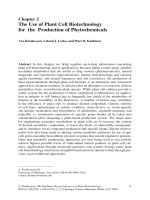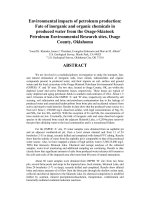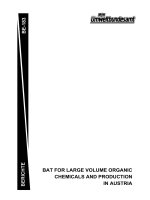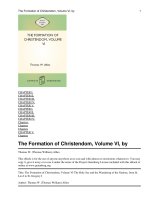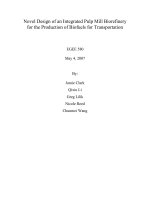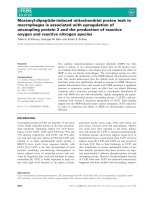The Production of Large Volume Organic Chemicals (EPR 4.01) pptx
Bạn đang xem bản rút gọn của tài liệu. Xem và tải ngay bản đầy đủ của tài liệu tại đây (747.78 KB, 51 trang )
How to comply with your environmental permit
Additional guidance for:
The Production of Large
Volume Organic
Chemicals (EPR 4.01)
Published by:
Environment Agency
Rio House
Waterside Drive,
Aztec West Almondsbury,
Bristol BS32 4UD
Tel: 0870 8506506
Email:
www.environment-agency.gov.uk
© Environment Agency
All rights reserved. This document may be reproduced with
prior permission of the Environment Agency. March 2009
GEHO0209BPIU-E-E
Contents
Introduction 2
Installations covered 3
Key issues 4
1. Managing your activities 8
1.1 Environmental performance indicators 8
1.2 Accident management 8
1.3 Energy efficiency 8
1.4 Efficient use of raw materials and water 9
1.5 Avoidance, recovery and disposal of wastes 10
2. Operations 13
2.1 Design of a new process 13
2.2 Storage and handling of raw materials, products and wastes 15
2.3 Plant systems and equipment 15
2.4 Reaction stage 18
2.5 Separation stage 20
2.6 Purification stage 22
2.7 Chemical process controls 23
2.8 Analysis 23
3. Emissions and monitoring 25
3.1 Point source emissions 25
3.2 Fugitive emissions 30
3.3 Odour 34
3.4 Noise and vibration 35
3.5 Monitoring and reporting of emissions to air and water 35
4. Annexes 39
Annex 1- Emission benchmarks 39
Annex 2- Other relevant guidance and abbreviations 46
Environment Agency How to comply with your environmental permit The production of large volume organic chemicals (EPR4.01) 1
Introduction
Introduction
In “Getting the basics right – how to
comply with your environmental permit”
(GTBR) we described the standards and
measures that we expect businesses to
take in order to control the risk of pollution
from the most frequent situations in the
waste management and process
industries.
This sector guidance note (SGN) is one of
a series of additional guidance for Part
A(1) activities listed in Schedule 1 of the
Environmental Permitting Regulations (the
Regulations). We expect you to use the
standards and measures in this note in
addition to those in GTBR to meet the
objectives in your permit.
Sometimes, particularly difficult issues
arise such as problems with odour or
noise. You may then need to consult the
“horizontal” guidance that gives in depth
information on particular topics. Annex 1
of GTBR lists these.
The IPPC Directive requires that the Best
Available Techniques (BAT) are used.
When making an application, explain how
you will comply with each of the indicative
BATs in this sector guidance note. Where
indicative BAT is not included, where you
propose to use an alternative measure or
where there is a choice of options you
should explain your choice on the basis of
costs and benefits. Part 2 of Horizontal
Guidance Note H1 Environmental Risk
Assessment (see GTBR Annex 1) gives a
formal method of assessing options which
you should use where major decisions are
to be made.
We will consider the relevance and relative
importance of the information to the
installation concerned when making
technical judgments about the installation
and when setting conditions in the permit.
Modern permits describe the objectives (or
outcomes) that we want you to achieve.
They do not normally tell you how to
achieve them. They give you a degree of
flexibility.
Where a condition requires you to take
appropriate measures to secure a
particular objective, we will expect you to
use, at least, the measures described
which are appropriate for meeting the
objective. You may have described the
measures you propose in your application
or in a relevant management plan but
further measures will be necessary if the
objectives are not met.
The measures set out in this note may not
all be appropriate for a particular
circumstance and you may implement
equivalent measures that achieve the
Environment Agency How to comply with your environmental permit The production of large volume organic chemicals (EPR4.01) 2
Introduction
Environment Agency How to comply with your environmental permit The production of large volume organic chemicals (EPR4.01) 3
same objective. In cases where the
measures are mandatory this is stated.
In response to the application form
question on Operating Techniques, you
should address each of the measures
described as indicative BAT in this note as
well as the key issues identified in GTBR.
Unless otherwise specified, the measures
and benchmarks described in this note
reflect those of the previous Sector
Guidance Note. They will be reviewed in
the light of future BREF note revisions. In
the meantime we will take account of
advances in BAT when considering any
changes to your process.
Installations covered
This note applies to activities regulated
under the following section of schedule 1
of the Regulations:
Section 4.1 - Organic Chemicals
Part A(1)
a) Producing organic chemicals such as:
(i) hydrocarbons (linear or cyclic,
saturated or unsaturated, aliphatic or
aromatic)
(ii) organic compounds containing
oxygen, such as alcohols, aldehydes,
ketones, carboxylic
acids, esters, ethers, peroxides, phenols,
epoxy resins
(iii) organic compounds containing
sulphur, such as sulphides, mercaptans,
sulphonic acids, sulphonates, sulphates
and sulphones and sulphur heterocyclics
(iv) organic compounds containing
nitrogen, such as amines, amides, nitrous,
nitro- or azo-compounds, nitrates, nitriles,
nitrogen heterocyclics, cyanates,
isocyanates, di-isocyanates and di-
isocyanate prepolymers
(vi) organic compounds containing
halogens, such as halocarbons,
halogenated aromatic compounds and
acid halides
(viii) plastic materials, such as polymers,
synthetic fibres and cellulose-based fibres
(ix) synthetic rubbers.
These chemical manufacturing processes
include a wide range of different
processes with some common features.
They are often related to a petroleum
refinery, from which they may receive raw
materials and utilities and may return by-
products and wastes.
Directly associated activities
As well as the main activities described
above, the installation will also include
directly associated activities which have a
direct technical connection with the main
activities and which may have an effect on
Introduction
Environment Agency How to comply with your environmental permit The production of large volume organic chemicals (EPR4.01) 4
emissions and pollution. These may
involve activities such as:
• storage and handling of raw materials
• storage and dispatch of finished
products, waste and other materials
• control and abatement systems for
emissions to all media
• waste treatment or recycling
• combustion plant
• air separation plan
The impact of the installation’s activities on
the wider environment may be more
extensive than immediately around the on-
site operations. This note, in line with the
requirements of the Regulations, covers
issues downstream of the installation such
as the final disposal of wastes and
wastewater.
Key issues
The key issues are:
Design of plant and processes
You should optimise processes and
techniques at the design stage as this will
reduce the potential for emissions and
reduce the need for abatement plant to be
retrofitted. For example:
• minimising the number of connections
in pipework will reduce the opportunity
for leaks and fugitive emissions
• care should be taken when selecting
construction materials, since severe
corrosion can be encountered in some
situations
• noise and vibration from furnaces and
combustion equipment can be
moderated at the design stage
• careful design of building layout taking
into consideration the proximity of
neighbours can sometimes avoid
problems
• site drainage should be designed so
that spillages of chemicals, lubricants,
etc., are routed to the effluent system,
with provision to contain surges and
storm-water flows
• good design of flares tips can reduce
the need for high rates of steam
injection and provide a quieter
operation
• the choice and design of cooling
systems can have a significant effect
on the release of uncondensed VOCs.
An increase of a few degrees in
condensation temperature may result
in a multiple increase in VOC
emissions.
There are many other examples
.
Point source emissions to air
Many processes release dust, fume or wet
particulates, some of which may contain
toxic substances such as heavy metal
compounds. Some processes release acid
gases, ammonia or volatile inorganic or
organic compounds.
Releases from point sources should be
individually characterised , including those
Introduction
Environment Agency How to comply with your environmental permit The production of large volume organic chemicals (EPR4.01) 5
from process and storage vessels as well
as those from abatement systems.
Fugitive VOC emissions to air
Installations have large numbers of plant
items, flanges, pumps and valves, storage
tanks, tanker connections, sample points,
etc. which have the potential for leakage of
VOCs. This can occur through relaxation
or progressive wear-and-tear of sealing
materials, through poor operation,
maintenance or design, or through failure
of equipment. Apart from releases of
material through accidental mal-operation
or equipment failure, fugitive losses from
individual pieces of equipment are usually
small, but the aggregated total can be
significant.
Waste minimisation and waste disposal
routes
Reaction specificity, kinetics, yield, etc are
major factors in the generation of waste.
For many syntheses the ratio of waste to
product is high - so the key issue is to
avoid waste generation in the first place
by optimizing the reaction arrangements.
Some parts of the sector generate
significant quantities of waste that are non-
combustible, so there are major disposals
to landfill. The Landfill Directive reduces
the options for disposal of many chemical
waste streams. You must minimise waste
as far as possible, always re-using and
recycling in preference to disposal.
Point source emissions to water
Producing effluent streams containing
complex pollutants such as mixed soluble
and insoluble organics, chlorinated
hydrocarbons, heavy metals, or non-
biodegradable compounds should be
avoided where possible. Where this is not
practicable these waste water streams
need to be minimized and then segregated
and treated separately before being
discharged to communal effluent treatment
facilities.
Energy efficiency
Many installations use large amounts of
energy, and the release to air of
combustion products is often the biggest
single environmental impact by the
installation. Most installations will be
participants to a Climate Change
Agreement or a Direct Participant
Agreement but even at these installations
there may be some issues which need to
be addressed in the permitting process.
Odour
Many of the substances produced or used
have the odour potential to cause offence
to neighbouring communities. Odours
arise from handling inherently malodorous
substances and also from fugitive releases
of organic solvents. This is a major
concern for some installations.
Introduction
Environment Agency How to comply with your environmental permit The production of large volume organic chemicals (EPR4.01) 6
Chemical analysis and monitoring of
emissions
To improve consistency and comparability
of reporting it is imperative that
consistency is applied to the streams and
substances that are monitored and to the
methods of analysis used.
Accident prevention and control
Whilst major accident hazards and
associated environmental risks are likely
to be covered by the requirements of the
COMAH Regulations, you should
demonstrate that you have lesser risks
well controlled. Loss of containment of
liquids that have contaminated land,
groundwater and surface water are
particular issues in this sector.
1
Managing your
activities
1.1 Environmental performance
indicators
mental performance
indicators
1.2 Accident management 1.2 Accident management
1.3 Energy efficiency 1.3 Energy efficiency
1.4 Efficient use of raw materials and
water
1.4 Efficient use of raw materials and
water
1.5 Avoidance, recovery and disposal of
wastes
1.5 Avoidance, recovery and disposal of
wastes
Environment Agency How to comply with your environmental permit The production of large volume organic chemicals (EPR4.01) 7
1 Managing your activities
Environmental performance
indicators
Accident management
Energy efficiency
Environment Agency How to comply with your environmental permit The production of large volume organic chemicals (EPR4.01) 8
1. Managing your activities
1.1 Environmental performance indicators
Indicative BAT
You should where appropriate:
1. Monitor and benchmark your environmental performance, and review this at least once a
year. Your plans for minimising environmental impacts should be incorporated into on-
going Improvement Programmes. Indicators can be derived using the Horizontal
Guidance Note H1 Environmental Risk Assessment (see GTBR Annex 1). It is suggested
that indicators are based on tonnes of organics produced (tOP) as they provide a good
basis for measuring performance within an installation or a single company year on year.
1.2 Accident management
In addition to the guidance in Getting the
Basics Right , guidance prepared in
support of the COMAH Regulations may
help you in considering ways to reduce the
risks and consequences of accidents,
whether or not they are covered by the
COMAH regime.
Guidance is available on the Health and
Safety Executive website as well as the
Environment Agency website.
1.3 Energy efficiency
Some large processes are major users of
heat and power and others produce
energy from their exothermic reactions.
For these there may be greater
opportunities for optimising energy
efficiency in comparison to the smaller
installations in the sector and to many
other industrial sectors.
The integrated sites have the greatest
scope for energy integration in the sector
but there is a practical limit to the
complexity of highly integrated systems
which can be effectively operated.
Knock-on difficulties can occur during
sequential start up and during major
upsets so the absolute maximum of
process integration may not always
produce the best environmental
performance in practice.
1 Managing your activities
Energy Efficiency
Efficient Use of Raw Materials
and Water
Environment Agency How to comply with your environmental permit The production of large volume organic chemicals (EPR4.01) 9
Indicative BAT
You should where appropriate:
1. Assess the environmental impact of each process and choose the one with the lowest
environmental impact. (However, we recognise that your choice may be constrained, for
example, by the integration of processes on a complex site).
1.4 Efficient use of raw materials and water
As a general principle, you need to
demonstrate the measures you take to:
• reduce your use of all raw materials
and intermediates
• substitute less harmful materials, or
those which can be more readily
abated and when abated lead to
substances that are more readily dealt
with
• understand the fate of by-products and
contaminants and their environmental
impact.
In the chemical sectors raw material
selection is usually fixed by the chemistry
and
chemical engineering design of the
process. There may be several different
processes that can be used to
manufacture a particular product but these
may differ in product yield, in the wastes
that they generate and in the potential for
environmental harm of their raw materials.
The purity of raw materials will often affect
yields and the presence of impurities may
result in the need for excessive recycle
and/or recovery operations with
consequent higher energy consumption.
The use of high purity raw materials will
generally minimise the environmental
impact of that process but may have other
adverse consequences, e.g. the use of
oxygen rather than air may have benefits
in reduced emissions to air but these have
to be weighed against the energy
requirements for air separation, as well as
any cost implications.
Water is used widely for cooling, for
process use and for cleaning.
A recirculating system with indirect heat
exchangers and a cooling tower is
preferable to a once-through system for
cooling purposes. This avoids most of the
heat transfer to the aquatic environment
and reduces the risk of undetected
contamination. It is also likely to reduce
the quantity of treatment chemicals
needed. However, you are likely to need a
water make-up treatment plant and there
will be a concentrated purge stream from
the system. You can sometimes use air
cooling in place of water but the fans
needed use energy and may be noisy.
1 Managing your activities
Efficient use of raw materials
and water
Avoidance, recovery and
disposal of wastes
Environment Agency How to comply with your environmental permit The production of large volume organic chemicals (EPR4.01) 10
Water may be used in direct contact with
process materials for either scrubbing or
quench cooling. In most cases you can
recirculate the water after stripping out the
absorbed substances. You will normally
need a purge stream to avoid the build-up
of contaminants and to remove water that
is produced in the process. This will need
treatment before discharge (although in
some cases it may be used in another
process).
Water used for cleaning can be reduced
by a number of techniques, e.g. by using
dry methods where possible and spray
cleaning rather than whole vessel filling.
Water should be reused wherever possible
and a hierarchy of sources and
opportunities for reuse may be established
using pinch analysis.
Indicative BAT
You should where appropriate:
1. Maximise heat transfer between process streams where water is needed for cooling. Use
a recirculating system with indirect heat exchangers and a cooling tower in preference to
a once-through cooling system.
2. Where water is used in direct contact with process materials, recirculate the water after
stripping out the absorbed substances.
3. Use cleaning techniques that reduce the quantity of water needed.
4. Establish opportunities for reuse using pinch analysis.
1.5 Avoidance, recovery and disposal of wastes
Waste should be recovered unless it is
technically or economically impractical to
do so.
You should list in detail the nature and
source of the waste from each activity as
the response to the emissions inventory
requirement of the Application. Where
there are a very large number of relatively
small streams it may be appropriate to
aggregate similar and comparatively
insignificant waste streams.
1 Managing your activities
Avoidance, recovery and
disposal of wastes
Environment Agency How to comply with your environmental permit The production of large volume organic chemicals (EPR4.01) 11
Indicative BAT
You should where appropriate:
1. Demonstrate that the chosen routes for recovery or disposal represent the best
environmental option. Consider avenues for recycling back into the process or reworking
for another process wherever possible.
2. Where you cannot avoid disposing of waste, provide a detailed assessment identifying the
best environmental options for waste disposal.
2 Chapter title
Section title
2
Operations
2.1 Design of a new process
2.2 Storage and handling of raw
materials, products and wastes
2.3 Plant systems and equipment
2.4 Reaction stage
2.5 Separation stage
2.6 Purification stage
2.7 Chemical process controls
2.8 Analysis
Environment Agency How to comply with your environmental permit The production of large volume organic chemicals (EPR4.01) 12
2 Operations
Design of a new process
Environment Agency How to comply with your environmental permit The production of large volume organic chemicals (EPR4.01) 13
2. Operations
Introduction
Suitable techniques to prevent pollution
and to minimize it at source are discussed
under the following headings:
• design of a new process
• storage and handling of raw materials,
products and wastes
• plant systems and equipment
• reaction stage
• separation and isolation
• purification and/or final product
preparation
• chemical process controls
• analysis
It is not possible to include all techniques
which could be classed as “clean
technology” because the sector is so
diverse.
2.1 Design of a new process
During new project development,
environmental issues should be an integral
part of discussion at every stage of the
design, beginning with the initial concepts.
At the initial stage of the development of
the process there should be a formal and
comprehensive study - the first stage in a
formal HAZOP study - of the likely
environmental consequences from:
• the use of all raw materials, and
production of all intermediates and
products
• all routine emissions, discharges and
solid/liquid waste streams and
• non-routine or unplanned releases and
disposals from, for example:
– start-ups and shutdowns
– off-specification products
– spillages and
– pressure relief.
You should plan to measure, control and
record the quantity and quality of every
emission, discharge and waste stream
from the process. This includes releases
generated from non-routine cleaning or
maintenance operations.
You should consider all realistic options for
minimising pollution from the outset, and
where end-of-pipe techniques are
proposed, the costs of abatement, waste
treatment and waste disposal should be
formally compared with alternatives for
waste minimisation at source.
The whole study should use formal
HAZOP techniques, and the quality and
effectiveness of the study will depend
upon the calibre and the commitment of
the members of the team involved - which
should include process engineers, design
engineers, operational staff (including
2 Operations
Design of a new process
Environment Agency How to comply with your environmental permit The production of large volume organic chemicals (EPR4.01) 14
those who operate shared facilities like
waste-water treatment plants, etc) and it is
vital that environmental specialists are
also members of the team.
A key purpose of the first part of the
HAZOP study is the production of a
preliminary environmental statement for
the proposed operation, and this should
cover the following points:
• Identification and characterisation.
This should identify all potential
releases.
• Segregation of all releases. This
allows measurement and diagnosis; it
also retains the flexibility to pursue
recovery, recycling and other waste
minimisation opportunities.
• Treatment of waste streams at source.
Most segregated waste streams are
more concentrated, of lower volume,
and less complex mixtures than
combined flows so separate treatment
should be considered.
• Containment of spills. It is important to
ensure that all potential spillages are
contained, the potential for recovery
considered and, where this is not
feasible, suitable disposal routes
developed.
• Fugitive emissions. Specification of
equipment should take into account
the likelihood of fugitive emissions,
and the positions of piping and of
vessels should allow rapid detection
and rectification of leaks.
• Provision for effluent flow equalisation
and for emergency discharges. If
effluent treatment is on-site the
installation must be capable of dealing
with fluctuations in flow, composition
and concentration, which usually
means the provision of holding and
balancing tanks.
• Emergency effluent storage may be
required to cope with unusual events
such as fire-fighting water.
• Abatement system reliability. If, in the
event of primary system failure, the
process cannot be stopped quickly
enough to prevent an emission then
strong consideration should be given
to the provision of a secondary back-
up system.
Indicative BAT
You should where appropriate:
1. Consider all potential environmental impacts from the outset in any new project for
manufacturing chemicals.
2. Undertake the appropriate stages of a formal HAZOP study as the project progresses
through the process design and plant design phases. The HAZOP studies should
consider amongst other things the points noted above.
2 Operations
Storage and handling of raw
materials, products and wastes
Plant systems and equipment
Environment Agency How to comply with your environmental permit The production of large volume organic chemicals (EPR4.01) 15
2.2 Storage and handling of raw materials, products and wastes
The design of storage facilities depends
upon the properties of the raw materials,
products and wastes that are being stored.
This includes their toxicity, environmental
persistence and flammability. Storage
areas are subject to the same risks as the
main processing areas: overpressure,
leakage, equipment failure and fire.
However the material inventories are
generally greater and the level of
surveillance is generally lower.
Additional guidance on the storage of
chemicals is provided in the “Emissions
from Storage” BREF (see Reference 3).
Indicative BAT
You should where appropriate:
1. Store reactive chemicals in such a way that they remain stable, such as under a steady
gas stream, for example. If chemical additions are necessary then tests should be carried
out to ensure the required chemical composition is maintained. Inhibitors may also be
added to prevent reactions.
2. Vent storage tanks to a safe location.
3. Use measures to reduce the risk of contamination from large storage tanks. In addition to
sealed bunds, use double-walled tanks and leak detection channels.
4. Use HAZOP studies to identify risks to the environment for all operations involving the
storage and handling of chemicals and wastes. Where the risks are identified as
significant, plans and timetables for improvements should be in place.
2.3 Plant systems and equipment
A wide range of ancillary equipment is
required throughout the process, which
may include: ventilation, pressure relief,
vacuum raising, pumps, compressors,
agitators, valves, purging and
heating/cooling. Some of these systems
give rise to a waste stream, e.g. wet
vacuum systems or dust extraction
equipment, and all of them have the
potential to give rise to fugitive emissions.
You should formally consider potential
emissions from plant systems and
equipment such as:
• the concentration, mass-flow and impact
of the substances vented to atmosphere
• the potential for contamination by extract
air of rain-water run-off from the roof
2 Operations
Plant systems and equipment
Environment Agency How to comply with your environmental permit The production of large volume organic chemicals (EPR4.01) 16
• whether the ventilation system should be
fed to an abatement unit
• noise levels and adequate silencing
arrangements.
Valve leakage performance is significant in
minimising fugitive losses and should be a
major factor in valve selection. The duties
and conditions in each vessel and section
of piping should be considered in a
systematic HAZOP study to identify and
quantify significant risks to the
environment from the valves chosen for
those parts of the plant activity in question.
Indicative BAT
You should where appropriate:
1. Formally consider potential emissions from plant systems and equipment and have plans
and timetables for improvements, where the potential for substance or noise pollution from
plant systems and equipment has been identified.
2. Carry out systematic HAZOP studies on all plant systems and equipment to identify and
quantify risks to the environment.
3. Choose vacuum systems that are designed for the load and keep them well maintained.
Install sufficient instrumentation to detect reduced performance and to warn that remedial
action should be taken.
Over-pressure protection systems
Most pressurised vessels will use relief
valves or bursting discs, or a combination
of the two, to provide emergency pressure
relief. Venting may be through an
absorption system, to a dump tank or
directly to atmosphere, and the need to
collect and treat the release will depend on
the likely impact of a discharge. The relief
system must be designed to cope with all
conceivable conditions, because the
vented stream might be liquid or a two-
phase foaming mixture, which would
impose different design constraints from
simple gas relief. All equipment installed in
the venting system should be maintained
in a state of readiness even though the
system is rarely used. Sometimes a small-
capacity relief valve is installed,
discharging to an abatement system, with,
in parallel and at a slightly higher pressure
setting and discharging directly to
atmosphere, a large-capacity device to
deal with fire induced relief.
2 Operations
Plant systems and equipment
Environment Agency How to comply with your environmental permit The production of large volume organic chemicals (EPR4.01) 17
Indicative BAT
You should where appropriate:
1. Carry out a systematic HAZOP study for all relief systems, to identify and quantify
significant risks to the environment from the technique chosen.
2. Identify procedures to protect against overpressure of equipment. This requires the
identification of all conceivable over-pressure situations, calculation of relief rates,
selection of relief method, design of the vent system, discharge and disposal
considerations, and dispersion calculations. In some cases careful design can provide
intrinsic protection against all conceivable over-pressure scenarios, so relief systems and
their consequential emissions can be avoided.
3. Maintain in a state of readiness all equipment installed in the venting system even though
the system is rarely used.
Heat exchangers and cooling systems
All heat exchange systems have the
potential for process streams to leak into
the heating/cooling fluid, or vice versa.
The “Industrial Cooling Systems” BREF
(see Reference 3) provides detailed
information on BAT for water-cooled heat
exchangers and cooling-tower systems.
Indicative BAT
You should where appropriate:
1. Consider leak detection, corrosion monitoring and materials of construction, preferably in
a formal HAZOP study. Plans and timetables for improved procedures or replacement by
higher integrity designs should be in place where the risks are identified as significant.
2. If corrosion is likely, ensure methods for rapid detection of leaks are in place and a
regime of corrosion monitoring in operation at critical points. Alternatively, use materials
of construction that are inert to the process and heating/cooling fluids under the
conditions of operation.
3. For cooling water systems, use techniques that compare favourably with relevant
techniques described in the Industrial Cooling Systems BREF.
2 Operations
Plant systems and equipment
Reaction stage
Environment Agency How to comply with your environmental permit The production of large volume organic chemicals (EPR4.01) 18
Purging facilities
Plant will normally require purging with air
between batches and campaigns, and
prior to maintenance activities; similarly,
prior to start-up, air is often displaced from
the system by an inert gas to ensure that a
flammable atmosphere does not form.
Purging leads to non-condensable gases
carrying organic vapours being vented
from the system.
Indicative BAT
You should where appropriate:
1. Assess the potential for the release to air of VOCs and other pollutants along with
discharged purge gas and use abatement where necessary.
2.4 Reaction stage
It is important to consider how the
chemistry and engineering options may
contribute to releases to the environment
from the reaction stage, both directly and
as a consequence later in the process. It is
also important that these considerations
are made at the process design stage -
before plant design and equipment
selection is commenced. It is difficult to
overstate the importance of an adequate
understanding of the physical chemistry
involved in the reaction scheme, followed
by sound application of reactor
engineering principles at the process
design stage.
Indicative BAT
You should where appropriate:
1. With a clear understanding of the physical chemistry, evaluate options for suitable
reactor types using chemical engineering principles.
2. Select the reactor system from a number of potentially suitable reactor designs -
conventional stirred tank reactor (STR), process-intensive or novel-technology - by formal
comparison of costs and business risks against the assessment of raw material
efficiencies and environmental impacts for each of the options.
3. Undertake studies to review reactor design options based on process-optimisation where
the activity is an existing activity and achieved raw material efficiencies and waste
2 Operations
Reaction stage
Environment Agency How to comply with your environmental permit The production of large volume organic chemicals (EPR4.01) 19
generation suggest there is significant potential for improvement. The studies should
formally compare the costs and business risks, and raw material efficiencies and
environmental impacts of the alternative systems with those of the existing system. The
scope and depth of the studies should be in proportion to the potential for environmental
improvement over the existing reaction system.
4. Maximise process yields from the selected reactor design, and minimise losses and
emissions, by the formalised use of optimised process control and management
procedures (both manual and computerised where appropriate).
5. Minimise the potential for the release of vapours to air from pressure relief systems and
the potential for emissions of organic solvents into air or water, by formal consideration at
the design stage - or formal review of the existing arrangements if that stage has passed.
Minimisation of vapour losses
There are many techniques for minimising
the potential for vapour losses and for
collection and abatement of vapour
displaced into vent lines.
For example, during the charging of
vessels, vapour losses can be reduced by
using dip-pipe or bottom-filling instead of
splash-filling from the top. This also
reduces the risks of static-induced
explosion. Organics evaporated from
reactor systems can be collected ahead of
an abatement system in order to achieve
direct recovery of the material, the most
common method being condensation. You
should always consider opportunities to
enhance the performance of abatement
systems, e.g. by increasing the heat
transfer area or chilling the coolant
medium for condensation, or by changing
the packing or absorbent in absorption
towers.
Indicative BAT
You should where appropriate:
1. Review your operating practices and review vent flows to see if improvements need to be
made.
2. Consider opportunities to enhance the performance of abatement systems.
2 Operations
Separation stage
Environment Agency How to comply with your environmental permit The production of large volume organic chemicals (EPR4.01) 20
2.5 Separation stage
On completion of the reaction it is usually
necessary to separate the desired product
from the other components in the reaction
system.
Liquid-vapour separations
The most widely used vapour-liquid
separation techniques are evaporation,
steam- or gas-stripping and distillation.
Contaminants in the liquid phase can
cause excessive foaming and the
presence of inert non-condensable gases
can depress the performance of
condensers.
Indicative BAT
You should where appropriate:
1. Choose your separation technique following a detailed process design and HAZOP
study. Follow formal operating instructions to ensure effective separation and
minimisation of losses. Adhere to design conditions such as heat input, reflux flows
and ratios, etc.
2. Install instrumentation to warn of faults in the system, such as a temperature,
pressure or low coolant-flow alarms.
Liquid-liquid separations
The most widely used liquid-liquid
separation techniques are 2-phase
extraction with water or solvent,
decantation, centrifuging and multi-stage
contacting.
Small quantities of surfactant substances
can affect dispersion and coalescence,
and even with good separation there is
usually a secondary haze which, typically,
accounts for up to 1% of the required
substance remaining in the wrong phase
and ending up in the waste stream.
2 Operations
Separation Stage
Environment Agency How to comply with your environmental permit The production of large volume organic chemicals (EPR4.01) 21
Indicative BAT
You should where appropriate:
1. Use techniques which maximise physical separation of the phases (and also aim to
minimise mutual solubility) where practicable.
2. When the phases are separated, use techniques which prevent (or minimise the
probability and size of) breakthrough of the organics phase into a waste-water stream.
This is particularly important where the environmental consequences of subsequent
releases of organics to air or into controlled waters may be significant (e.g. where the
effluent is treated in a DAF unit or some of the organic components are resistant to
biological treatment).
3. Where you are discharging to drain, consider whether there should be an intermediate
holding or "guard" tank to protect against accidental losses from the organics phase.
Solid-liquid separations
Different separation techniques will be
BAT for different applications, with factors
like solubility, crystallisation rate and
granular size being important. The main
solid-liquid techniques are centrifuging,
filtration, sedimentation, clarification,
drying and ion exchange.
Indicative BAT
You should where appropriate:
1. Use techniques to minimise, re-use and/or recycle rinse water, and to prevent
breakthrough of solids.
2. Install instrumentation or other means of detecting malfunction as all of the techniques are
vulnerable to solids breakthrough.
3. Consider installing "guard" filters of smaller capacity downstream which, in the event of
breakthrough, rapidly 'clog' and prevent further losses.
4. Have good management procedures to minimise loss of solids, escape of volatiles to air
and excessive production of waste water.
2 Operations
Purification stage
Environment Agency How to comply with your environmental permit The production of large volume organic chemicals (EPR4.01) 22
2.6 Purification stage
Waste associated with the purification
stage may arise from:
• Impurities in the raw materials - so a
change in the raw material specifications
may reduce waste arisings.
• By-products generated by the process -
so a change in reaction conditions,
catalyst, solvent, etc may improve the
selectivity of the reaction and reduce or
eliminate by-product formation.
Purification of liquid products
Liquid products are usually refined by
distillation, with filtration used to remove
solid contaminants. Sources of loss are:
• Gas entrainment. Gas or vapour flow will
carry away volatile material either as
vapour or as entrained droplets.
Additional condenser heat-exchange
area or colder heat-exchange fluid can
improve the recovery rate, and
coalescing demisters are relatively
cheap and easy to install.
• Ineffective separation. A better
separation in the distillation column can
be achieved by using more stages
(theoretical plates) or more reflux.
Modern types of packing or high-
efficiency trays can often produce a
marked improvement for a modest
capital investment.
• Filtration. Enclosed filtration is usually
used and this is not normally a source of
great vapour loss to air. Liquid
discharged during cleaning or changing
of filters should be returned to the
process.
Purification of solid products
Washing and crystallising activities have
the potential to produce large volumes of
dilute liquors so counter-current systems
of operation should be used wherever
possible.
During drying, you should aim to produce
the maximum concentration of solvent in
the gas to allow recovery of the solvent.
The use of vacuum can improve both
solvent recovery and energy efficiency.
2 Operations
Chemical process controls
Analysis
Environment Agency How to comply with your environmental permit The production of large volume organic chemicals (EPR4.01) 23
2.7 Chemical process controls
Reaction conditions such as temperatures,
pressures, rocking or stirring rates,
catalyst age, input and output flow rates,
addition of materials (and so on) are
imperative to the efficient conversion of
raw materials to product.
Indicative BAT
You should where appropriate:
1. Monitor the relevant process controls and set with alarms to ensure they do not go out of
the required range.
2.8 Analysis
Indicative BAT
You should where appropriate:
1. Analyse the components and concentrations of by products and waste streams to ensure
correct decisions are made regarding onward treatment or disposal. Keep detailed
records of decisions based on this analysis in accordance with management systems.

